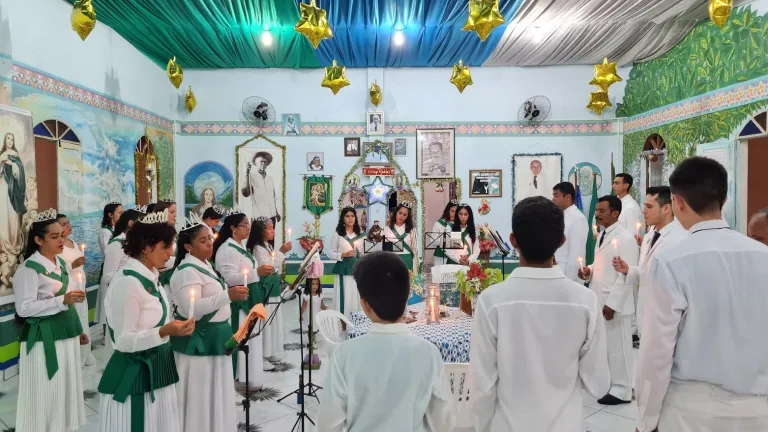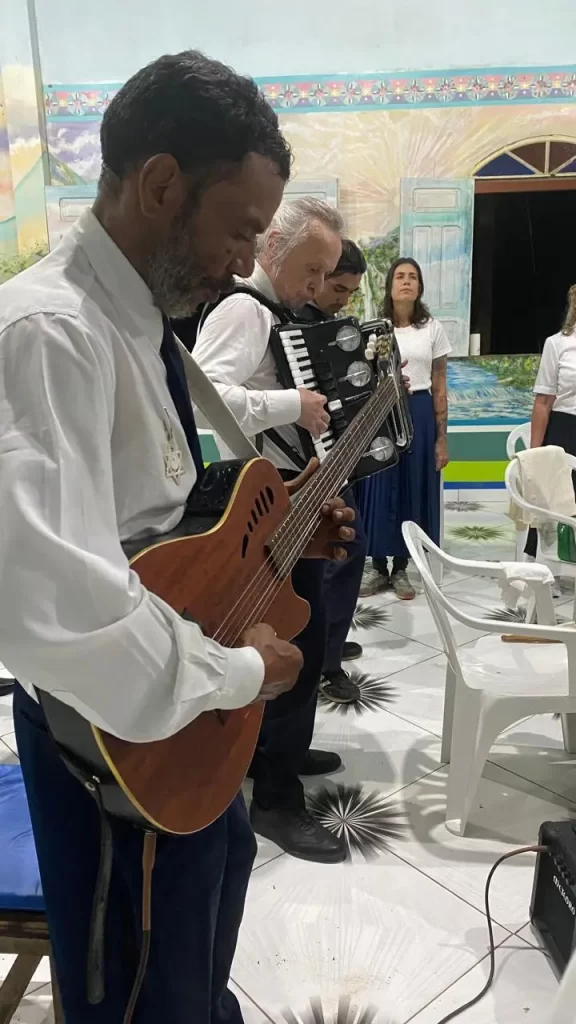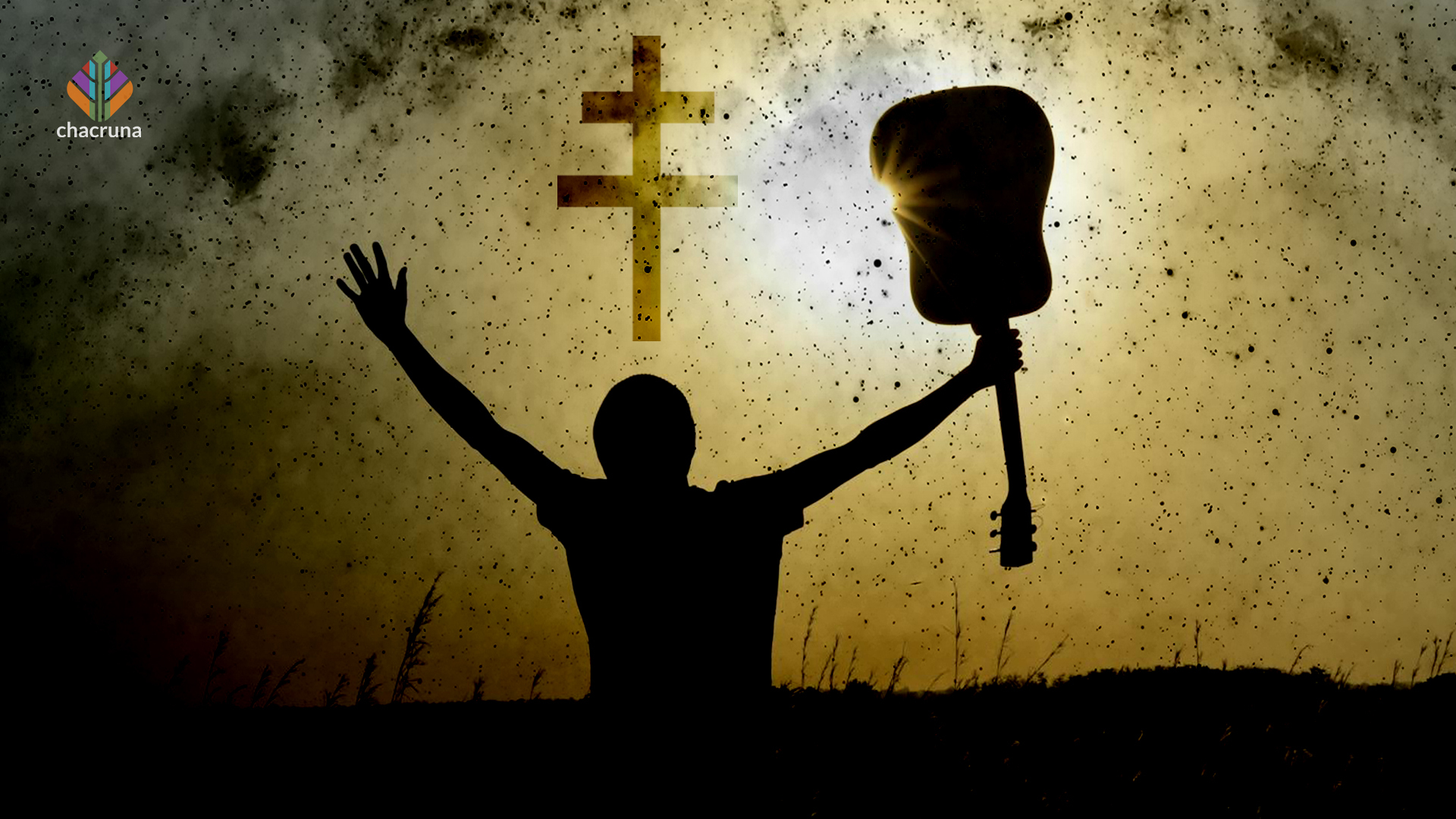- Music and Body in the Brazilian Santo Daime Tradition - May 8, 2024
- Psychedelic Culture and the Future of the Psychedelic Movement - April 27, 2024
- Eight Frequently Asked Questions About Ayahuasca Globalization - February 13, 2024
- Music and Body in the Brazilian Santo Daime Tradition - May 8, 2024
- Eight Frequently Asked Questions About Ayahuasca Globalization - February 13, 2024
- Liberté, Égalité et Fraternité? Santo Daime’s Fight for Religious Freedom in France - February 15, 2023

Music is a vital element in most groups and traditions that are centered around the ritual use of ayahuasca (Labate & Pacheco, 2010; Luna, 2011). When it comes to the Brazilian Santo Daime tradition, the central role of music is well-known. Several works have highlighted the role of music in this tradition. They have addressed important issues, such as the relationship between music and silence in rituals (Abramovitz 2002), the connections between music, language, and translation in the Santo Daime diaspora (Labate et al., 2017), the role of music in shaping notions of self (Rehen, 2016) and in identity processes (Rabelo, 2013), among other subjects. However, we want to focus on an aspect that has not yet been fully explored by the literature: the importance of the relationship between music and body in Santo Daime. By this relationship, we mean the multiple ways that music contributes to instilling embodied dispositions and the importance of learning techniques that shape the body of a daimista.
The Santo Daime ceremony, which is called a trabalho (work, as in “to labor”), is conducted mainly through the performing of live music, or more specifically, hymns.
The notion that Santo Daime is a musical doctrine is not a novelty; but what does that mean? The Santo Daime ceremony, which is called a trabalho (work, as in “to labor”), is conducted mainly through the performing of live music, or more specifically, hymns, to put it in daimista terms. One might wonder, however, what is the difference between “music” and “hymns”? It is well known by daimistas that Santo Daime hymns are not “composed,” but instead “received.” As Rehen (2007) points out, receiving a hymn is different from composing a piece of music. Although musical compositions may be influenced by intangible factors such as “inspiration” or even “intuition,” the composer is the subject of the authorship process. She can experiment, alter, and influence the music in all its dimensions, be it rhythmic, harmonic, melodic, and poetic, “creating” or “inventing” it. Hymns are instead received through a process often described as a sort of musical psychography, in which the “receiver” listens, memorizes, and later reproduces the melody and lyrics.
In the Santo Daime tradition, there are the official hymnals, such as O Cruzeiro from Santo Daime’s founder, Mestre Raimundo Irineu Serra, that are sung in every Santo Daime church on certain Catholic feast and saints dates of the year, such as Three Kings’ Day, St. John’s, the Virgin of Immaculate Conception, and Christmas. However, every daimista can potentially receive hymns and develop their own hymnal collection.

In the beginning, it was Mestre himself who had the authority to define the authenticity of a hymn received by a particular member (Rabelo, 2012). Over time, he appointed a helper, D. Percília, who was allowed to correct, adapt, or cut hymns. However, the expansion of the different branches of Santo Daime throughout Brazil and internationally, coupled with the absence of an official form of validation, gave rise to an exponential increase in the number of hymns received by Brazilians and foreigners in the most diverse parts of the world. Since there is no precondition for receiving hymns, a person does not need to have a lot of experience and years of practice. No musical talent or prior musical ability is required.
So, if it is not composed, what defines the experience of receiving a hymn? Where does it come from? Who is the author of the lyrics and the composer of the music? Callicot (2013) associates the acquisition of shamanic icaros, a type of ayahuasca shamanic music found in Indigenous and mestizo communities of the western Amazon, as a form of interspecies communication. That is, music is seen as a form of conversation between plants and people. As a product of two-way communication between the shaman and psychedelic plants, the notion of interspecies communication introduces the possibility of the agency of non-human beings. Moreover, as in Santo Daime, this communication process necessarily involves the improvement of the apprentice’s sensory capacities and learning abilities.
As a product of two-way communication between the shaman and psychedelic plants, the notion of interspecies communication introduces the possibility of the agency of non-human beings.
Beyond the similarities between the shaman who acquires an icaro and the daimista who receives a hymn, however, there is a major difference that should be noted. The Santo Daime works are marked by a collective musical performance by all the participants in the ritual. Therefore, there is no clear distinction between musicians and the audience, as almost everyone present participates in the musical performance (Abramovitz, 2002). During the rituals, the hymns are sung in unison and accompanied by acoustic guitars and other available musical instruments, such as accordions, flutes, bass guitars, etc., sharing a musical experience while drinking daime. One cannot forget to mention one core musical element of Santo Daime’s musicality: the maracá, a percussive instrument that is considered by some as part of the uniform, and that keeps the tempo of the work and dictates its musical rhythm.
Hence, the musical performance of hymns is essential for the execution of the work and, since it is done live by all the participants, there can be changes in keys and tempo depending on how the work is conducted, the number of people, and if they are predominately males, who usually prefer lower registers, or females, who often choose higher keys. Moreover, everyone present, not only church members, takes part in the musical performance, singing and sometimes dancing (Abramovitz, 2002).

The centrality of the musical component in Santo Daime rituals demands that every daimista learn how to play the maraca. Moreover, they must master the bodily skill to play it while dancing and singing in particular musical genres, such as waltz, march, and mazurka. They must train their bodies to sing in tune and to follow the rhythm of the music that is being played. And, if you are a non-Brazilian member of Santo Daime, you have to learn how to do that in a foreign language that is surely not easy to learn. As Flecha’s (2023) work points out, the corporeal knowledge of the bailado (Santo Daime’s dance work) is revealed through its kinesthetic simplicity. It involves several aesthetic stimulants that engage the senses, including taste, smell, visual effects, and sound. These stimulants, as Flecha states, emphasize the role of corporeality in Santo Daime. At this point, one can see that embodiment processes are an integral part of the Santo Daime experience, and the musical element plays a central role in shaping the daimista body.
In turn, if a daimista is out of rhythm or is singing out of tune, that has a direct effect on the musical performance and, consequently, on the dynamic of the work. That has nothing to do with believing or not in the Daime and following a certain moral code, but with how the body is molded in a specific setting, within a tradition whose ritual instills several body techniques and modes of perception. Santo Daime is an interesting case that showcases, in Hirschkind’s (2006) terms, how bodily techniques and modes of perception underlie specific forms of historical experience. The focus of the ayahuasca experience shifts, thus, from a cognitivist approach to the perceptual capacities and how the sensory abilities are culturally shaped through disciplinary practices of self-cultivation.
Given that embodied knowledge is a central element of collective life, the experience of drinking Santo Daime in a ritual setting cannot be reduced to the learning of forms of subjectivity that are shared by a cultural tradition.
On focusing on the embodied dispositions, we do not want to downplay the role of inner subjective experiences, nor to deny the importance of the symbolic and cognitive dimensions. However, the singular emphasis on interior experience when examining the religious use of psychedelics, such as in the ritual use of Daime, does not take into account the modes of perception and the embodied learning that sustain traditions and paths to communal transcendence. Given that embodied knowledge is a central element of collective life, the experience of drinking Santo Daime in a ritual setting cannot be reduced to the learning of forms of subjectivity that are shared by a cultural tradition. In sum, we want to put forward the idea that Santo Daime is not primarily a religion of consciousness, but a tradition of the body in its entirety.
Note: This article was originally published in MAPS Bulletin: Volume XXXIV Number 1 • 2024.
Art by Mariom Luna.
References
Abramovitz, R. S. M. (2002). Música e silêncio na concentração do Santo Daime [Music and silence in Santo Daime’s concentration]. Cadernos Do Colóquio, 5(1), 20–29. https://seer.unirio.br/coloquio/article/view/60
Callicott, C. (2013). Interspecies communication in the Western Amazon: Music as a form of conversation between plants and people. European Journal of Ecopsychology, 4, 32–43. https://citeseerx.ist.psu.edu/document?repid=rep1&type=pdf&doi=0c56b921fa1d6ac4f1fa71d7fb813a414384ddbd
Flecha, A. (2023). Currents of knowledge: The Santo Daime bailado as decolonial dance. Revista Brasileira De Estudos Da Presença, 13(3), 1–26. https://seer.ufrgs.br/index.php/presenca/article/view/128060
Hirschkind, C. (2006). The ethical soundscape: Cassette sermons and Islamic counterpublics. Columbia University Press.
Labate, B. C., Assis, G. L., & Cavnar, C. (2017). A religious battle: Musical dimensions of the Santo Daime Diaspora. In B. C. Labate, C. Cavnar, & A. K. Gearin (Eds.), The world ayahuasca diaspora: Reinventions and controversies (pp. 99–121). Routledge.
Labate, B. C., & Pacheco, G. (2010). Opening the portals of heaven. Brazilian ayahuasca music. Lit Verlag.
Luna L. E. (2011). Indigenous and mestizo use of ayahuasca: An overview. In R. G. Santos (Ed.), The ethnopharmacology of ayahuasca (pp. 1–21). Transworld Research Network.
Rabelo, K. (2012). Recepção e validação de hinos na Doutrina do Daime [Reception and validation of hymns in the Daime doctrine]. ABHR Symposium proceedings, 13, São Luís, UFMA. https://revistaplura.emnuvens.com.br/anais/article/view/475
Rabelo, K. (2013). Daime música: Identidades, transformações e eficácia na música da doutrina do Daime [Daime music: Identities, transformations and efficacy in the music of the Santo Daime doctrine] [Master’s thesis]. Federal University of Minas Gerais, Brazil.
Rehen, , L. K. F. (2007). “Receber não é compor:” música e emoção na religião do Santo Daime [“Receiving is not composing:” Music and emotion in the Santo Daime religion]. Religião & Sociedade, 27(2), 181–211. https://doi.org/10.1590/S0100-85872007000200009
Rehen, L. K. F. (2016). Texto e contexto da música no santo daime: algumas considerações sobre a noção de “eu” [Text and context of Santo Daime music: Some considerations on the notion of “self”]. Mana, 22(2), 469–492. https://doi.org/10.1590/1678-49442016v22n2p469
Take a minute to browse our stock:
Did you enjoy reading this article?
Please support Chacruna's work by donating to us. We are an independent organization and we offer free education and advocacy for psychedelic plant medicines. We are a team of dedicated volunteers!
Can you help Chacruna advance cultural understanding around these substances?
















